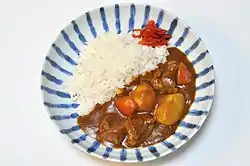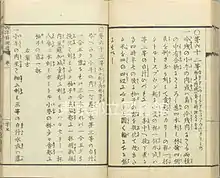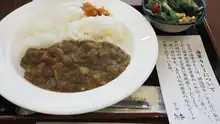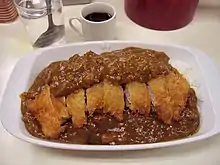 A plate of Japanese-style curry with rice | |
| Type | Curry |
|---|---|
| Place of origin | Japan |
| Serving temperature | Hot |
| Main ingredients | Vegetables (onions, carrots, potatoes), meat (beef, pork, chicken) |
| Variations | Karē raisu, karē udon, karē-pan |
Japanese curry (カレー, karē) is commonly served in three main forms: curry over rice (カレーライス, karē raisu), curry udon (curry over thick noodles), and curry bread (カレーパン, karē pan) (a curry-filled pastry). It is one of the most popular dishes in Japan.[1] The very common "curry rice" is most often referred to simply as "curry" (カレー, karē).
Along with the sauce, a wide variety of vegetables and meats are used to make Japanese curry. The basic vegetables are onions, carrots, and potatoes. Beef, pork, and chicken are the most popular meat choices. Katsu curry is a breaded deep-fried cutlet (tonkatsu; usually pork or chicken) with Japanese curry sauce.[2]
In the UK, katsu curry is sometimes applied to any type of Japanese curry.[3]
Overview
Curry originates in Indian cuisine and was brought to Japan from India by the British. The Imperial Japanese Navy used curry to prevent the malnutrition condition beriberi, and in the present day the Japan Maritime Self-Defense Force's Friday menu is curry.[4] It is also nutritious, and easy to cook in mass quantities.[5] The dish became popular and available for purchase at supermarkets and restaurants in the late 1960s. Since the introduction of curry, it was reinvented to suit Japanese tastes and ingredients.[6] Japanese curry has little resemblance to curries from other regions.[1] The dish has changed and been adapted so much since its introduction that it stands on its own as uniquely Japanese.[6] It is so widely consumed that it can be called a national dish.[1]
History


Curry was introduced to Japan during the Meiji era (1868–1912).[6] At the time the Indian subcontinent was under British colonial rule.[6] Anglo-Indian officers of the Royal Navy brought the spice mix called curry powder to Japan.[6] It was classified as yōshoku (Western food) since it came from the West.[6] The word curry was probably adopted into the Japanese language as karē in the late 1860s, when Japan was forced to abandon its isolation (sakoku) and came into contact with the British Empire.[7] By the 1870s, curry began to be served in Japan, and became a staple within the Japanese diet.[8]
Curry is commonly eaten as a rice dish in Japan, karē raisu (curry rice). The oldest Japanese mention of a dish called raisu karē (literally 'rice curry')—but as the misspelt taisu karē—is in cookbooks from 1872.[6] It was also described in an 1872 report, according to which foreign experts ate this at the Tokyo branch of the Hokkaidō prefectural government. However, the word was popularized by American professor William S. Clark who was employed at the Sapporo Agricultural College (now University of Hokkaido) in 1877.[9][10] For 1873, there was a dish called curry rice on the menu of the Imperial Japanese Army Military Academy.[7] Since its introduction it was reinvented with ingredients from Japanese cuisine to make it suitable for Japanese tastes.[6]
It was not until the early twentieth century, when curry was adopted by the Japanese Navy and Army, that the dish began to become popular with the Japanese.[11] After its favorable reception within the Japanese Army and Navy, it later became common in school cafeterias.[12] By 2000, curry was a more frequent meal than sushi or tempura.[12] The fame of the dish in Japan is mainly due to the Imperial Japanese Navy, which was modeled after the Royal Navy, whose sailors ate a meat stew with curry seasoning and bread as a side dish for their voyages, which was also provided by the Japanese Navy. This was called the kaigun karē ('navy curry') of beef or chicken meat, potatoes, onions, carrots, rice and curry roux and a chutney of pickled vegetables (tsukemono) as described in the 1888 cookbook Kaigun kappōjitsu (海軍割烹術, 'Navy Cooking Methods'). The Maritime Self-Defense Force took over this tradition after the war and serves it every Friday with a salad,[13][14][15] with each ship having its own variant.[16]
In the civil sector, curry was particularly popular at the beginning of the Meiji period (1868–1912), as it first had to be imported, and was still an exclusive dish that could only be eaten in expensive restaurants specializing in Western cuisine. In the Taishō period (1912–1926), the dish became affordable for the general population, especially towards the end, with the introduction of domestically produced curry mixes.[17]
Today, curry is one of the most popular daily dishes in Japan. In 2013, production totaled 7,570 tons of curry powder and 91,105 tons of ready-made sauces; sales in 2008 amounted to 7 billion yen for curry powder and 86 billion yen for ready-made sauces.[18]
Curry similar to that served in the Indian subcontinent is known as Nakamura-ya curry. It was introduced to Japan by Rash Behari Bose (1886–1945) when he began to sell curry at Nakamura-ya, a bakery in Tokyo.[19]
Sauce mixes
Curry sauce (カレーソース, karē sōsu) is served on top of cooked rice to make curry rice.[20] Curry sauce is made by frying together curry powder, flour, and oil, along with other ingredients, to make roux; the roux is then added to stewed meat and vegetables, and then simmered until thickened.[21] Pressure cooking can be used as well.[20] Adding potatoes to curry sauce was introduced by William S. Clark due to rice shortages at the time.[22]
In Japanese homes, curry sauce is most commonly made from instant curry roux, which is available in block and powder forms. These contain curry powder, flour, oils, and various flavorings. Ease of preparation, variety, and availability of instant curry mixes made curry rice very popular, as it is very easy to make compared to many other Japanese dishes. Pre-made curry is available in retort pouches that can be reheated in boiling water. For those who make curry roux from scratch, there are also curry powders specially formulated to create the "Japanese curry" taste.[23]
Instant curry roux was first sold in powder form by House Foods in 1926, and in block form by S&B Foods in 1956. In 2007, Japanese domestic shipments of instant curry roux was 82.7 billion yen.[24] Market share for household use in 2007 was captured almost entirely by House Foods (59.0%), S&B Foods (25.8%) and Ezaki Glico (9.4%).[25][26] Curry is marketed to children utilizing characters from video games and anime.[27]
Retort pouch curry sauce, prepared by heating the retort pouch in hot water or the microwave, is also popular. As of 2007, curry sauce is the largest single category of vacuum-sealed foods in Japan, making up over 30% of sales.[24]
Serving
Japanese curry rice is served in anything from a flat plate to a soup bowl. The curry is poured over rice in any manner and amount. Japanese short-grain rice, which is sticky and round, is preferred, rather than the medium-grain variety used in Indian dishes. It is usually eaten with a spoon, as opposed to chopsticks, because of the liquid nature of the curry. Curry rice is usually served with fukujinzuke or rakkyō on the side.[28]
Other varieties



- Katsu curry (カツカレー, katsu karē): Curry rice served with a breaded pork cutlet on top.
- Dry curry (ドライカレー, dorai karē): Curry-flavored fried rice, or curry rice with a drier, mince meat curry sauce.
- maze karē (混ぜカレー): Curry rice, served with the sauce and rice already mixed. Popularized by the Jiyūken curry restaurants in Osaka.
- karē don (カレー丼): Curry sauce, thickened and flavored with mentsuyu or hondashi and served on top of a bowl of rice, to give the curry a Japanese flavor.
- aigake (合がけ): Rice served with curry sauce and hayashi sauce (fried beef and onion, cooked with red wine and demi-glace).
- yaki karē (焼きカレー): Curry rice, topped with a raw egg and baked in an oven. Originally from Kitakyushu.
- ishiyaki karē (石焼きカレー): Curry sauce with rice served in a heated stone bowl, in a similar way to dolsot bibimbap.
- Soup curry (スープカレー, sūpu karē): Soup curry, a watery, broth-like curry sauce served with chunky ingredients such as a chicken leg and coarsely-cut vegetables. Popular in Hokkaido.
Local curries
In the late 1990s, a number of regional specialty curries emerged, popularised as vacuum-sealed curry sauces. These include:
- Hokkaido sika deer curry (えぞ鹿カレー, ezoshika karē) from Hokkaido.
- Scallop curry (ほたてカレー, hotate karē) from Aomori Prefecture.
- Mackerel curry (サバカレー, saba karē) from Chiba Prefecture.
- Apple curry (リンゴカレー, ringo karē) from Nagano Prefecture and Aomori Prefecture.
- Nattō curry (納豆カレー, nattō karē) from Mito, Ibaraki.
- Nagoya Kōchin chicken curry (名古屋コーチンチキンカレー, Nagoya kōchin chikin karē) from Aichi Prefecture.
- Matsusaka beef curry (松阪牛カレー, Matsusaka gyū karē) from Mie Prefecture.
- Whale curry (クジラカレー, kujira karē) from Wakayama Prefecture.
- Oyster curry (牡蠣カレー, kaki karē) from Hiroshima Prefecture.
- Nashi pear curry (梨カレー, nashi karē) from Shimane Prefecture.
- Black pork curry (黒豚カレー, kurobuta karē) from Kagoshima Prefecture.
- Bitter melon curry (ゴーヤーカレー, gōyā karē) from Okinawa.
Local curries are also marketed to help boost tourism. Some varieties of this include Yokosuka navy curry (よこすか海軍カレー, Yokosuka kaigun karē), sold in Yokosuka to promote its heritage as a naval base,[29] and Zeppelin Curry (ツェッペリンカレー, Tsepperin Karē) in Tsuchiura to promote the Zeppelin landing in 1929.[30]
Outside Japan
South Korea
Curry was introduced to South Korea during the period of Japanese rule, and is popular there. It is often found at bunsik restaurants (diner-style establishments), donkkaseu-oriented restaurants, and at the majority of Japanese restaurants. Premade curry and powdered mixes are also readily available at supermarkets.
North Korea
Japanese-style curry was introduced to North Korea by Koreans and Japanese who were abducted from Japan to North Korea during the 1960s–1970s repatriation project.[31] Along with other Japanese cuisine, it was traded by new arrivals for local products and used to bribe Workers' Party cadres.[31]
Elsewhere
Mixes can be found outside Japan and Korea in supermarkets that have a Japanese section or in Japanese or Asian food stores. Mixes are also available from retailers online.[32]
The largest Japanese curry company in Japan is House Foods Corporation. The company operated more than 10 Curry House restaurants in the US until mid-2019 when it sold off its interest to CH Acquisitions LLC, which abruptly closed the restaurants in February 2020.[33] House Foods associated company CoCo Ichibanya (Ichibanya Co., Ltd.) or Kokoichi has more than 1,200 restaurants in Japan. CoCo Ichibanya has branches in China, Hong Kong, Korea, Singapore, Taiwan, Indonesia, Philippines, Thailand, United Kingdom, United States (more specifically Hawaii and California), and India.[34]
Japanese curry and curry sauce are sometimes referred to inaccurately as "katsu curry" in the UK, even in cases where the katsu (cutlet) itself is not included.[35]
See also
References
- 1 2 3 『カレーライス』に関するアンケート (in Japanese). ネットリサーチ ディムスドライブ. Archived from the original on October 23, 2021. Retrieved 1 February 2016.
- ↑ "Chicken katsu curry". Food recipes. BBC. 2016. Archived from the original on July 14, 2021. Retrieved 20 January 2016.
- ↑ "The U.K. Thinks Japanese curry is katsu curry, and people aren't happy about it". 12 February 2020. Archived from the original on 2021-05-17.
- ↑ Curry Recipe Archived 2019-01-27 at the Wayback Machine Japan Maritime Self-Defense Force (in Japanese)
- ↑ "Japan Ministry of Defense/Self-Defense Forces". Twitter. Japan Ministry of Defense. 25 August 2021. Archived from the original on 25 August 2021. Retrieved 19 October 2021.
- 1 2 3 4 5 6 7 8 Itoh, Makiko (26 August 2011). "Curry — it's more 'Japanese' than you think". The Japan Times. Archived from the original on 8 January 2018. Retrieved 31 March 2018.
- 1 2 ""Ricecurry and Curryrice"" ライスカレーとカレーライス (in Japanese). House Foods. Retrieved 14 February 2015.
- ↑ Bell, Markus (8 April 2016). "From India To North Korea, Via Japan: Curry's Global Journey". The Salt. National Public Radio. Retrieved 15 November 2018.
- ↑ "FAQ" よくある質問と回答 (in Japanese). Universität Hokkaidō. Retrieved 14 February 2015.
- ↑ "Sapporo Hitsujigaoka Observation Hill". さっぽろ羊ヶ丘展望台オフィシャルサイト (in Japanese). Archived from the original on 14 February 2015. Retrieved 14 February 2015.
- ↑ Tadashi Ono; Harris Salat (2013). Japanese Soul Cooking: Ramen, Tonkatsu, Tempura, and More from the Streets and Kitchens of Tokyo and Beyond. Ten Speed Press. p. 44. ISBN 978-1-60774-352-1.
- 1 2 Makalintal, Bettina (2 November 2018). "A Brief History of How Curry Ended Up in Japan". Munchies. Vice. Retrieved 15 November 2018.
- ↑ "Akebonos‚ Yokosuka Marine-Trockencurry' (tiefgefroren)")" あけぼの「よこすか海軍ドライカレー」(冷凍食品) (in Japanese). Maruha Ichiro. Archived from the original on 14 February 2015. Retrieved 14 February 2015.
- ↑ "Die wenig bekannte Geschichte der Geburt von Curryreis" カレーライス誕生秘話 (in Japanese). Stadt Yokosuka. 21 December 2012. Archived from the original on 21 February 2014. Retrieved 14 February 2014.
- ↑ "Curry-Rezepte der Marineselbstverteidigungsstreitkräfte" ★海上自衛隊のカレーレシピ★ (in Japanese). Ministry of Defense. Retrieved 14 February 2015.
- ↑ "Curry-Rezepte der Marineselbstverteidigungsstreitkräfte" ★海上自衛隊のカレーレシピ★ (in Japanese). Ministry of Defense. Retrieved 14 February 2015.
- ↑ "Wann hat sich Curry in japanischen Haushalten richtig durchgesetzt?" 日本人の家庭にカレーが本格的に広まったのはいつごろでしょうか? (in Japanese). S&B Foods. Archived from the original on 14 February 2015. Retrieved 14 February 2015.
- ↑ 生産量 (in Japanese). All Japan Curry Manufacturers Association. 2013. Retrieved 14 February 2015.
- ↑ Karmakar, Kaylan (25 September 2018). "Japanese Curry Is Nothing Like Indian Curry. Think Twice When in Japan". New Delhi: NDTV. Retrieved 17 November 2018.
- 1 2 "Easy Instant Pot Japanese Bone-in Chicken Curry". Asian Cooking Mom. 25 April 2020. Retrieved 26 April 2020.
- ↑ Nancy Singleton Hachisu (4 September 2012). Japanese Farm Food. Andrews McMeel Publishing. pp. 289–290. ISBN 978-1-4494-1830-4.
- ↑ Colburn Goto, Gina (21 November 2014). "Curry is king". Japan Today. Tokyo. Retrieved 13 February 2019.
- ↑ Itoh, Makiko (26 August 2011). "Curry — it's more 'Japanese' than you think". The Japan Times. Tokyo. Retrieved 13 February 2019.
- 1 2 生産量の推移 [Transition of Production] (in Japanese). All Japan Curry Manufacturers Association. Retrieved 7 March 2011.
- ↑ ハウス食品 [Hause Foods] (PDF) (in Japanese). Keio University Marketing Research Study Group. Archived from the original (PDF) on 12 April 2017. Retrieved 7 March 2011.
- ↑ コンサルティングレポート 江崎グリコ株式会社 [Proposal for Ezaki Glico] (PDF) (in Japanese). Kutsuna Seminar at Faculty of Business Administration in Kobe University. Archived from the original (PDF) on 22 July 2011. Retrieved 7 March 2011.
- ↑ Chris Kohler (10 October 2016). Power-Up: How Japanese Video Games Gave the World an Extra Life. Courier Dover Publications. p. 188. ISBN 978-0-486-81642-5.
- ↑ Jan Davison (15 May 2018). Pickles: A Global History. Reaktion Books. p. 33. ISBN 978-1-78023-959-0.
- ↑ Trautlein, Steve, "The chow-down tour of Kanto's local dishes Archived 2013-07-05 at the Wayback Machine", The Japan Times, 24 August 2012, p. 15
- ↑ Hongo, Jun (14 November 2013). "Tsuchiura city curries favor with visitors at its annual gourmet festival". Japan Times. Retrieved 30 November 2018.
- 1 2 Bell, Markus (8 April 2016). "From India To North Korea, Via Japan: Curry's Global Journey". The Salt. NPR. Retrieved 12 May 2016.
- ↑ "S&B Golden Curry Sauce Mix Medium Hot, 3.5 OZ". Walmart. Retrieved 26 April 2020.
- ↑ "Curry House Trends After All Japanese Curry and Spaghetti Restaurants Mysteriously Close". 2 October 2020. Archived from the original on 2 October 2020.
- ↑ "Japanese-style Curry Specialty Shop". ichibanya.co.jp.
- ↑ "The U.K. thinks Japanese curry is katsu curry, and people aren't happy about it". 12 February 2020. Archived from the original on 17 May 2021.
Further reading
- Eston, Elizabeth (2019). "The Footprints of the Indian Revolution in Japanese Food Culture". Rash Behari Bose: The Father of the Indian National Army, Vol. 1. Tenraidou.
- All Japan Curry Manufacturers Association (1 March 2019). "The World of Japanese Curry". Foodies Go Local. All Japan Curry Manufacturers Association. Archived from the original on 24 May 2019. Retrieved 24 May 2019.
- Ewbank, Anne (25 October 2018). "How Curry Became a Japanese Naval Tradition". Gastro Obscura. Atlas Obscura.
